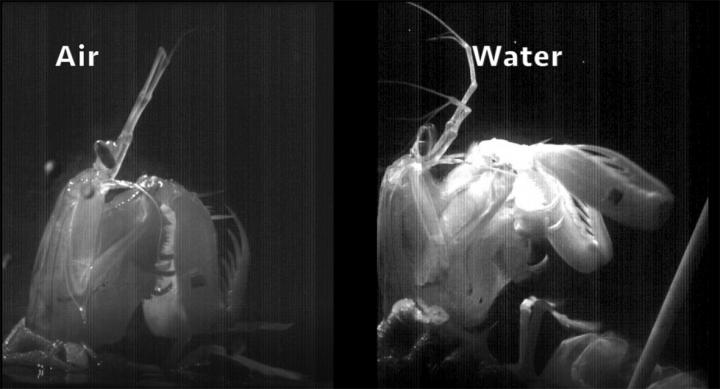
Credit: Kate Feller
Mantis shrimp (Squilla mantis) don’t take kindly to captivity. ‘They have a general baseline of being angry’, chuckles Kate Feller, currently at the University of Minnesota, USA, recalling how the contrary stomatopods are particularly keen to lash out when exposed to air. ‘I had developed a means of holding mantis shrimp with their striking appendages out of water while their gills [arranged beneath the tail] remained submerged for an electrophysiology study I was conducting’, recalls Feller. However, when Greg Sutton from the University of Lincoln, UK, wandered past her University of Cambridge (UK) lab bench, he noticed the exposed crustaceans and commented that it would be interesting to measure their hammer blows in air. ‘No one had done that’, explains Feller. Knowing that the animals launch their ballistic appendages at the speed of a bullet in dense water, it seemed likely that they could even exceed those eye-watering speeds in thinner air. However, when Feller set up Paloma Gonzalez-Bellido’s high speed camera to catch the angry animals in the act, she was astonished when she realised that the crustaceans’ blows were nowhere near as powerful out of the water as they were in it. They publish their discovery in Journal of Experimental Biology at http://jeb.
‘We stimulated them to strike by poking them in the abdomen with a blunt stick. It was like poking them in the tummy, which they hated’, she says, adding that the manoeuvre was not without risk. ‘I have a pretty epic photo of my bleeding hand over a white sink when one stabbed me during this process’, she smiles. And at first glance, the animals’ blows looked every bit as punchy as those beneath water. However, when Feller analysed the spring-loaded air-blows, she was puzzled; the manoeuvre was only half as fast: ‘The air strikes only averaged about 18 km h?1, which is pretty pitiful even for a slow striker like S. mantis‘, she says. In fact, when she and Sutton compared the mantis shrimp blows with another spring-loaded manoeuvre – grasshopper leaps – it turned out that the crustaceans were only packing 0.42W of power into their 1.2g hammers, the same as the leaping grasshoppers, even though they are capable of propelling their hammers in water with ten times more power (4W).
Puzzled by the mantis shrimps’ lacklustre performance, Feller and Sutton initially wondered if the animals’ spring-loaded propulsion mechanism was simply unable to transmit as much power in air as in water. But then, a paper by Sheila Patek’s lab was published showing that the crustaceans can fine-tune their blows depending on the context. Feller and Sutton realised that the exposed mantis shrimp were more likely downgrading their blows in the thinner material.
But why were the crustaceans pulling their punches when they could have taken the opportunity to make even more of a mess of Feller’s fingers? ‘My hypothesis is that this may be related to how mantis shrimp dissipate the excess energy of their strike’, she says. Locusts and other leaping insects have energy-absorbing structures at the back of the limb to protect joints from damage, whereas the explosive energy released by submerged mantis shrimps is usually dissipated by their tough opponents and the hard snail shells they target. ‘In air, not only are the forces of drag from water absent, but the entire sensory experience is messed up, so maybe – in the absence of a perceived target – the animals don’t give it the full pow so they don’t blow out their joint’, Feller suggests. In other words, the crustaceans’ pulled air-punches might simply be a matter of self-preservation.
###
IF REPORTING THIS STORY, PLEASE MENTION JOURNAL OF EXPERIMENTAL BIOLOGY AS THE SOURCE AND, IF REPORTING ONLINE, PLEASE CARRY A LINK TO: https:/
REFERENCE: Feller, K. D., Sutton, G. P., Gonzalez-Bellido, P. T. (2020). Medium compensation in a spring-actuated system. J. Exp. Biol. 223, jeb208678.
doi:10.1242/jeb.208678
This article is posted on this site to give advance access to other authorised media who may wish to report on this story. Full attribution is required, and if reporting online a link to jeb.biologists.com is also required. The story posted here is COPYRIGHTED. Therefore advance permission is required before any and every reproduction of each article in full. PLEASE CONTACT [email protected]
Media Contact
Kathryn Knight
[email protected]
44-012-236-32871
Related Journal Article
http://dx.




